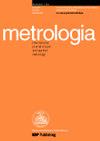Characteristic analysis of a controlled-clearance piston-cylinder assembly up to 1500 MPa using a finite element method
IF 2.4
3区 工程技术
Q2 INSTRUMENTS & INSTRUMENTATION
引用次数: 0
Abstract
Abstract We utilized numerical methods to analyze the characteristics of the piston-cylinder assembly of a controlled-clearance piston gauge. The piston gauge was able to measure liquid pressure from 100 MPa to 1500 MPa with the relative expanded uncertainty of 0.02% ( k = 3). We established a finite element model to solve the stress and strain of the structural problem. The effective areas were calculated based on Dadson’s formula using the converged solutions of the clearance and the pressure distribution within the distorted piston-cylinder engagement gap that were iteratively determined by the finite element model and a fluid mechanics model with pressure-dependent fluid’s properties. Results were compared to the effective areas calculated by the modified Heydemann–Welch model based on experimental data, and the relative differences were less than 0.02%. We found sharp declines of the clearance and pressure distribution near the exit of the piston-cylinder engagement gap, which may lead to wearing during long-time operation at high pressures. Numerical results indicated non-linear relationship between jacket pressure and the cubic root of piston fall speed, which was traditionally considered as linear. The stall jacket pressure obtained by cubic (instead of linear) fitting extrapolation was found more close to the ones determined directly by the finite element model. Numerical results also found non-linear relationships among jacket pressure, measuring pressure, jacket pressure distortion coefficient.利用有限元法对压力达1500mpa的控制间隙活塞-气缸总成进行特性分析
摘要采用数值方法分析了一种控制间隙活塞压力表活塞-气缸总成的特性。活塞式压力表能够测量100 ~ 1500 MPa范围内的液体压力,其相对扩展不确定度为0.02% (k = 3)。我们建立了有限元模型来求解结构问题的应力和应变。利用有限元模型和具有压力相关流体特性的流体力学模型迭代确定的变形活塞缸啮合间隙内间隙和压力分布的收敛解,基于Dadson公式计算有效面积。结果与基于实验数据的改进Heydemann-Welch模型计算的有效面积进行了比较,相对差异小于0.02%。我们发现在活塞-气缸啮合间隙出口附近的间隙和压力分布急剧下降,这可能导致在高压下长时间运行时磨损。数值计算结果表明,夹套压力与活塞下落速度的立方根之间存在非线性关系,而传统上认为这种关系是线性的。通过三次(而非线性)拟合外推得到的失速套压力更接近于有限元模型直接确定的失速套压力。数值结果还发现夹套压力、测量压力、夹套压力畸变系数之间存在非线性关系。
本文章由计算机程序翻译,如有差异,请以英文原文为准。
求助全文
约1分钟内获得全文
求助全文
来源期刊

Metrologia
工程技术-物理:应用
CiteScore
2.80
自引率
25.00%
发文量
137
审稿时长
12 months
期刊介绍:
Published 6 times per year, Metrologia covers the fundamentals of measurements, particularly those dealing with the seven base units of the International System of Units (metre, kilogram, second, ampere, kelvin, candela, mole) or proposals to replace them.
The journal also publishes papers that contribute to the solution of difficult measurement problems and improve the accuracy of derived units and constants that are of fundamental importance to physics.
In addition to regular papers, the journal publishes review articles, issues devoted to single topics of timely interest and occasional conference proceedings. Letters to the Editor and Short Communications (generally three pages or less) are also considered.
 求助内容:
求助内容: 应助结果提醒方式:
应助结果提醒方式:


